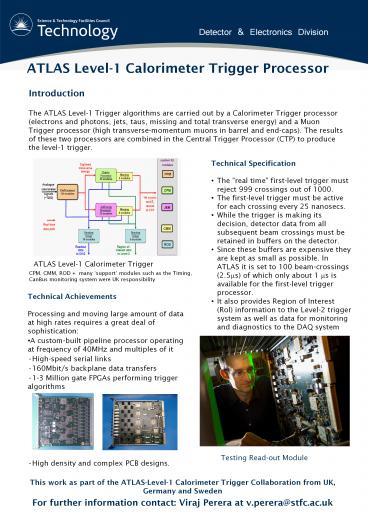ATLAS Level-1 Calorimeter Trigger Processor - PowerPoint PPT Presentation
1 / 1
Title:
ATLAS Level-1 Calorimeter Trigger Processor
Description:
ATLAS Level-1 Calorimeter Trigger Processor Introduction ... and a Muon Trigger processor (high transverse-momentum muons in barrel and end-caps). – PowerPoint PPT presentation
Number of Views:71
Avg rating:3.0/5.0
Title: ATLAS Level-1 Calorimeter Trigger Processor
1
Detector Electronics Division
ATLAS Level-1 Calorimeter Trigger Processor
Introduction The ATLAS Level-1 Trigger
algorithms are carried out by a Calorimeter
Trigger processor (electrons and photons, jets,
taus, missing and total transverse energy) and a
Muon Trigger processor (high transverse-momentum
muons in barrel and end-caps). The results of
these two processors are combined in the Central
Trigger Processor (CTP) to produce the level-1
trigger.
- Technical Specification
- The "real time" first-level trigger must reject
999 crossings out of 1000. - The first-level trigger must be active for each
crossing every 25 nanosecs. - While the trigger is making its decision,
detector data from all subsequent beam crossings
must be retained in buffers on the detector. - Since these buffers are expensive they are kept
as small as possible. In ATLAS it is set to 100
beam-crossings (2.5?s) of which only about 1 ?s
is available for the first-level trigger
processor. - It also provides Region of Interest (RoI)
information to the Level-2 trigger system as well
as data for monitoring and diagnostics to the DAQ
system
ATLAS Level-1 Calorimeter Trigger
CPM, CMM, ROD many support modules such as
the Timing, CanBus monitoring system were UK
responsibility
- Technical Achievements
- Processing and moving large amount of data at
high rates requires a great deal of
sophistication - A custom-built pipeline processor operating at
frequency of 40MHz and multiples of it - High-speed serial links
- 160Mbit/s backplane data transfers
- 1-3 Million gate FPGAs performing trigger
algorithms - High density and complex PCB designs.
Testing Read-out Module
This work as part of the ATLAS-Level-1
Calorimeter Trigger Collaboration from UK,
Germany and Sweden For further information
contact Viraj Perera at v.perera_at_stfc.ac.uk































